Interview Bias: A Comprehensive Guide
We’re all prone to biases, whether we’re aware of them or not. But hiring needs to stay objective and equitable. What managers need to know about interview bias.
5.0

Add an AI assistant to your interviews
Start with 5 interviews for free
Already have an account?
Log in
You’ve heard the tired clichés. Trust your first impression. You can tell everything you need to know about someone from their handshake (or maybe more apt in the 2020s, video call greeting). Go with your gut.
Thing is, these assumptions are often dead wrong. And that can be downright disastrous for hiring managers, who need to recommend the best candidate for job openings, since a bad hire can cost a company almost a quarter million dollars.
Even if you strive for a fair hiring process, free of any overt or hasty stereotyping, job interviews can still be fraught with unconscious bias. Everything from a job candidate’s mannerisms to where they grew up can play a huge role in whether hirers think they’re a good fit for a job — even when such details have nothing to do with their qualifications and are lousy predictors of future performance.
Interviews are often the make-or-break moment in a job application process. When done right, they’re the perfect proving ground. But if biases go unchecked, they can cloud managers’ judgment and lead to missing out on a great candidate.
According to one study, only 8% of interview decisions correctly predicted job performance. And in a survey of 9,000 talent professionals, 42% said bias is the main reason interviews fail at picking the best candidate.
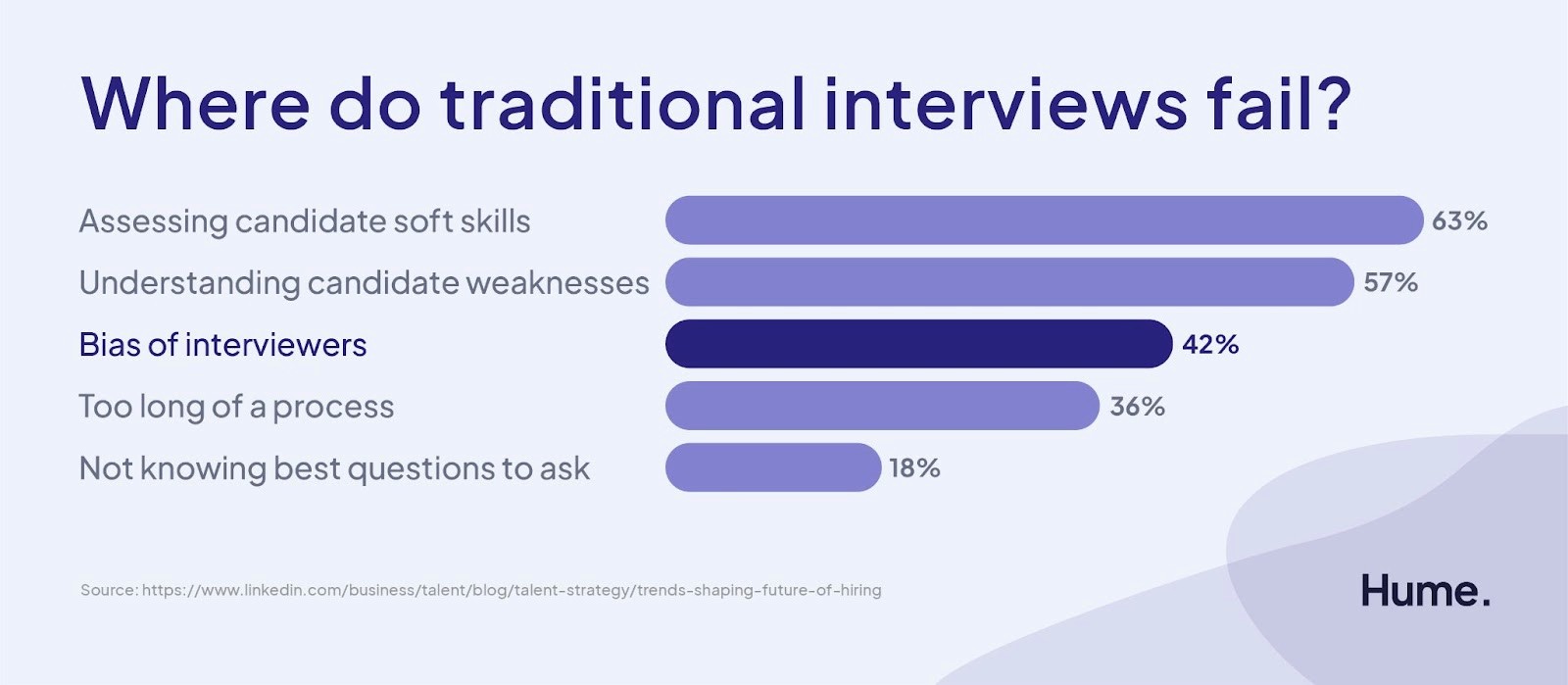
We all enter interactions with preconceived notions. It’s part of what makes us human. So consider this your guide to managing interview bias. First, how to identify it. Then, steps you can take to mitigate it, all while ensuring the fairest and most successful interview process.
What is interview bias?
What is interviewer bias? It’s what happens when an interviewer judges a candidate on criteria beyond the scope of the actual job. Sometimes an interviewer is aware of these snap judgments, sometimes they’re more subtle and subconscious. Either way, interview bias makes the hiring process less fair and less merit-based.
For example, maybe an interviewer for a web developer position was charmed by a candidate’s extraversion and sense of humor. She got the offer, but will those traits translate to on-the-job success if she’s writing code behind a computer screen all day?
What about the other candidate who was more timid during the interview and struggled making eye contact — should she lose out even though she’s a more thorough and experienced developer?
Interview bias can lead to hiring the wrong person, which in turn means high turnover and less workplace diversity.
Are all interviewers prone to bias?
There’s no sugar-coating it: yes.
The sneaky fact of unconscious bias is that it’s always at work, making snap judgments of people you meet based on your upbringing, experience, and environment without you even noticing. It’s the human brain’s way of quickly processing information and categorizing social worlds. Even interviewers steadfastly committed to fairness and inclusion can be swayed by a candidate’s gender or body language without knowing.
How do we know interview bias exists?
Mountains of evidence show the pervasive effects interview bias has on hiring decisions. In 2017, a National Bureau of Economic research study reviewed 40,000 applications and found that it was much harder for older workers to find jobs.
In a 2012 survey of more than 200 corporate leaders, 35% said “good grooming,” made women exude more of an “executive presence.” And 16% said “physical attractiveness” factored in.
Studies also show that hiring managers are influenced by how much money candidates make, where they went to school, and even how they speak. And according to the National Academy of Sciences, when a lesser performing candidate is hired over someone more qualified, two-thirds of the time the inferior candidate is a man.
10 types of interview bias
You can never eliminate interview bias. But being aware of the many forms it takes is a helpful first step toward subverting it. According to the Society of Human Resources Management, these are the different types.
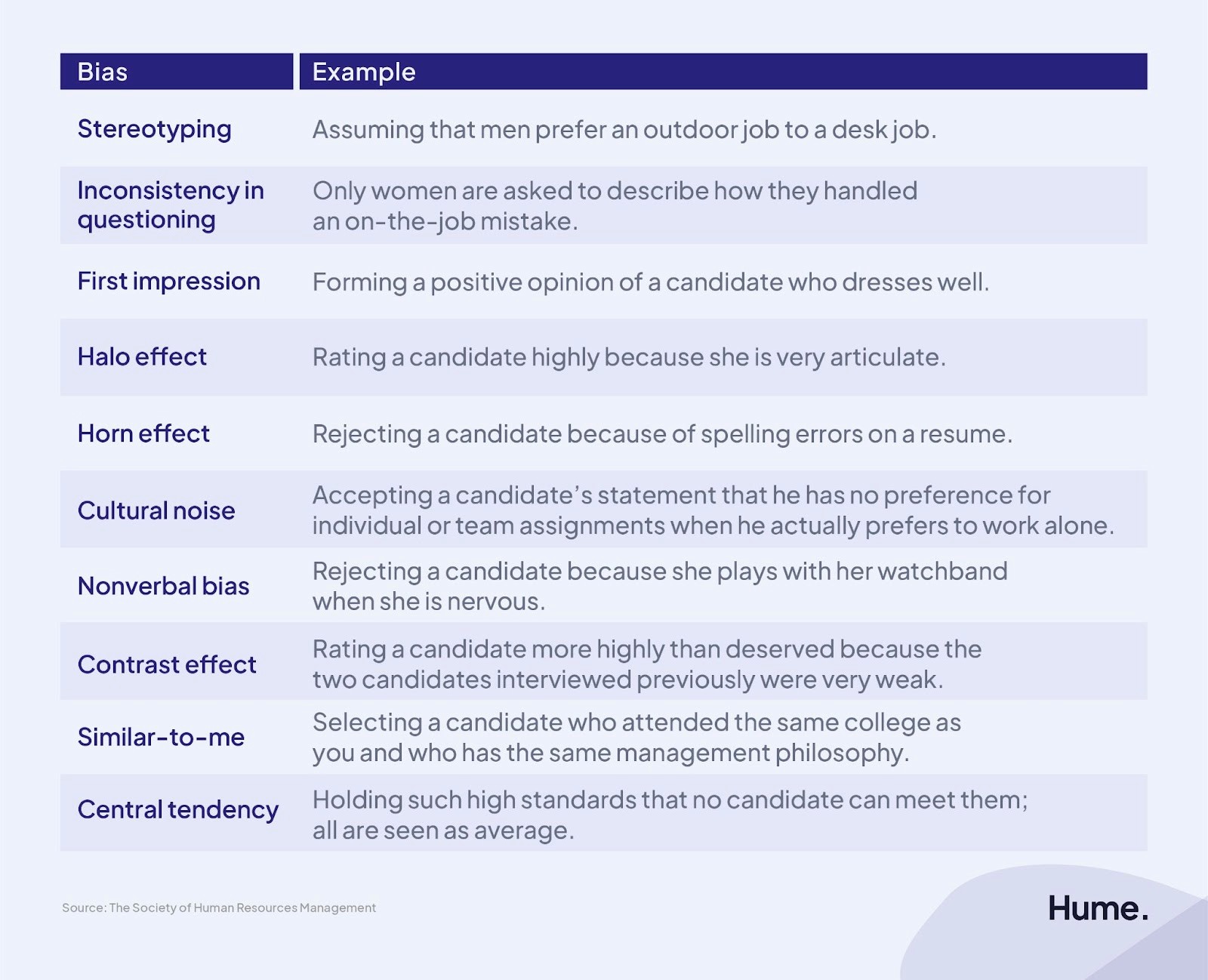
Stereotyping
Stereotyping bias is when hirers judge people based on their membership to an identity or group, like race, gender, or socioeconomic background. For instance, a construction recruiter may think men prefer to work outdoors. Or an office manager may think women are better suited to be receptionists.
It’s an obstacle Black women disproportionately face in getting jobs and getting ahead. One recruiter said she’d feel less comfortable hiring a woman of color with a natural hairstyle — like locs or an afro — because she looked less “clean cut,” than a woman of color with a straightened ponytail.
No matter the example, stereotyping obscures a candidate’s genuine qualifications in favor of misguided, surface-level judgments.
Inconsistency in questioning
This is when interviewers ask different questions to different candidates, meaning they're judging people based on separate, ever-changing criteria. For instance, maybe an interviewer quizzes Leslie, a product manager at an obscure start-up on how to maintain a requirement traceability matrix, but forgoes that line of questioning for Jacob, who worked at more of a name-brand company, like Microsoft, assuming he knows what that means and will have a good answer.
This exacerbates interview bias because inconsistent questioning means you're not judging candidates on a level playing field. If Leslie gives a response that affects whether someone wants to hire her, then Jacob needs to answer the same exact question to ensure a fair interview process. What if he, in fact, had no clue what a requirement traceability matrix was, and which a company only finds out after he gets hired? All things considered, Leslie could've been the better hire. But with a hodgepodge of interview questions, you'd have no way of knowing.
First impression
Remember — they’re not to be trusted! Interviewers are being biased when they form a judgment of someone right off the bat, whether favorable or unfavorable, and stick to that judgment throughout the interview process.
While first impressions are often wrong, they play an outsized role in hiring. According to a Yale study, interviewers judge candidates based on their perceived social status seconds after they start speaking. And a separate study showed that 60% of interviewers decide whether they think a candidate is suitable for the role within 15 minutes.

Halo effect
This is the term for overgeneralizing a candidate’s strength in one area to mean strength in several areas. For instance, you may be primed to think that since someone speaks three languages, they’re also a capable accountant. It’s important to not let one shiny skill overshadow an otherwise lackluster application.
Horn effect
This is the halo effect’s devilish opposite. A weakness in one area doesn’t mean weakness in others. For example, a grammar mistake on a resume may make for a tough sell for a copy editor position. But if the application is for a marine biologist and the candidate has years of relevant experience, is it really a huge deal?
Cultural noise
Cultural noise happens when a candidate ditches total candor in favor of trying to impress an interviewer. For instance, maybe you ask if a candidate is comfortable working slightly unconventional hours. The prospective employee says she doesn’t have a preference, even though in all honesty, she'd rather stick with the cookie cutter nine-to-five. This can often make for a bad workplace fit.
Nonverbal bias
Sometimes self-described body language doctors overfocus on nonverbal behavior. A candidate with a nervous tic could make a great engineer. Plus, that nervousness could evaporate a couple weeks into a new job.
Contrast effect
This is the tough (or easy) act to follow fallacy. Some average candidates benefit from interviewing immediately after bad ones, making them look better. And maybe a stellar candidate doesn’t shine as bright interviewing right after another superstar. When people are compared against each other instead of against a standardized rubric, biases can sway objectivity.
Similar-to-me
Conscious or not, interviewers can heavily favor candidates they share things in common with. When a sociologist surveyed bankers, lawyers, and consultants, they all claimed they gravitated towards people like themselves in interviews.
Also called affinity bias, this trend often worsens gender segregation in jobs — for instance, women teachers hiring more women teachers and male bankers hiring more male bankers — and perpetuates stereotypes.
Central tendency
If you’re looking for the perfect candidate and none of your 25 interviews fit the bill, maybe your standards are too high. The central tendency bias occurs when every candidate seems average. It favors comparing people to the platonic ideal employee (who maybe doesn’t exist), and makes it harder to distinguish candidates from one another.
10 ways to avoid interview bias in your hiring process
Because of these biases, all working nefariously to cloud your judgment, unstructured interviews can make for a terrible predictor of on-the-job performance.
The fix? Adding structure to your interviews, with guardrails in place that ensure decision-making is fair and inclusive.
It’s a worthy ideal. Reducing bias makes workplaces more diverse, and leads to a 35% performance increase above industry means.
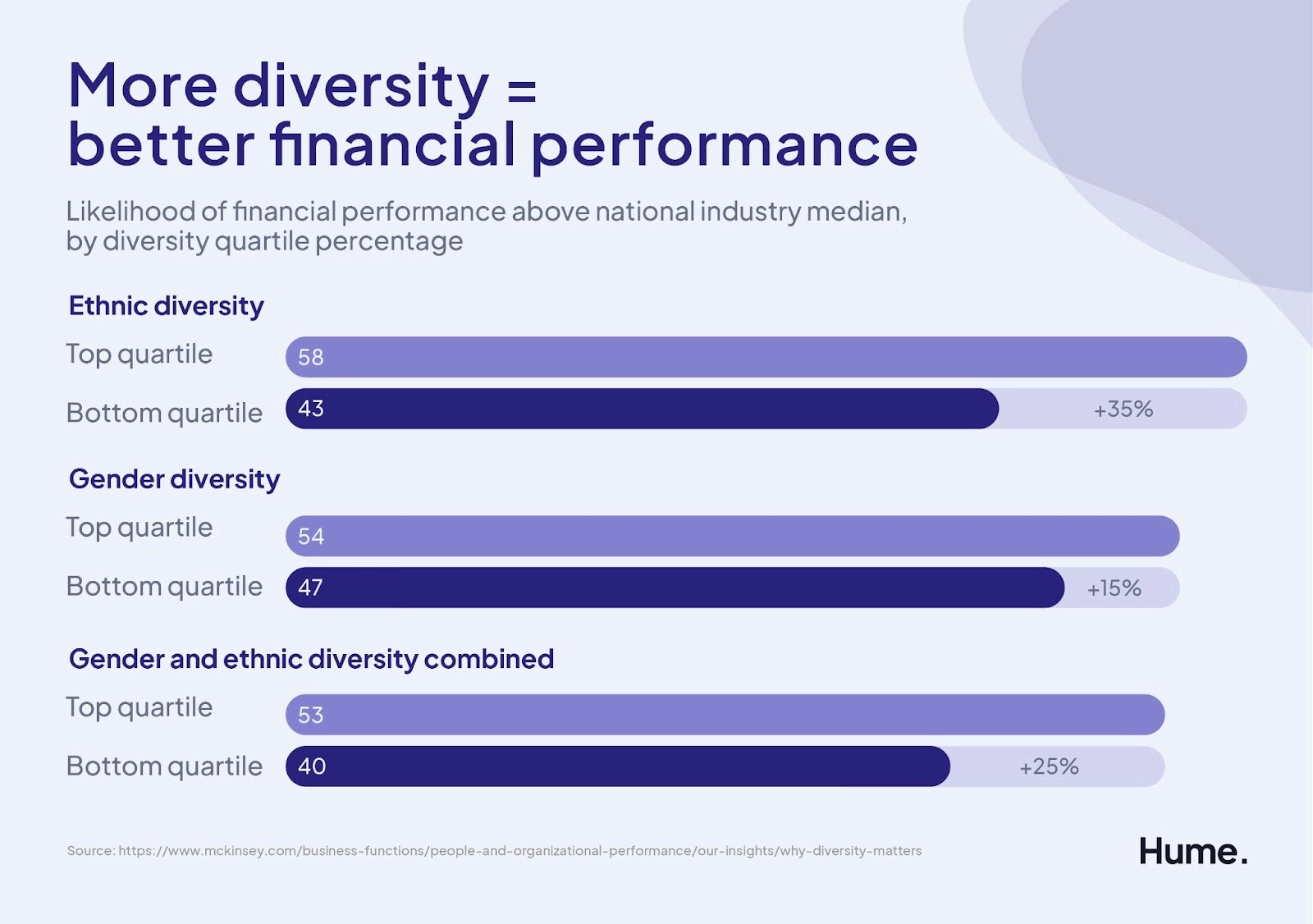
Here are some tips to get you started:
Define the job, not the person
Minimizing interview bias starts with the job description. Hiring managers shouldn’t seek specific personality traits — like someone who’s extroverted — or have any stringent degree requirements. Instead, the posting should define performance objectives — measurable goals like convert 10 leads per quarter.
If job descriptions are results-based, specifying what employees are expected to achieve, you can open up your candidate pool and be less seduced by people you want to hire just because they're charming.
Recruit everywhere
If you only interview candidates who already live near your office, you're severely limiting your hiring pool. Provided the job can be done remotely, expanding the geographical scope of your recruitment process means more competitive, diverse candidates.
For jobs that need to be in-person, it's also often worth covering moving costs for candidates willing to relocate. You may need to limit your search for Visa or otherwise legal reasons, but besides that, candidates from all over should be fair game.
But recruiting broadly also means advertising your job opening across multiple channels. One Indeed post only gets you so far. The savvier you are about seeking out listservs that cater to underrepresented communities (say, the Association of Black Accountants for a bookkeeper job), the likelier you are to have a hiring pool more representative of the world at large — which makes it easier to couch against interview bias.
Standardize interview questions
When interviewing a wide range of candidates, you get the fairest results when you ask them the same exact questions, in the same exact order. This helps hirers compare and contrast responses, and ensures you don’t go down any tangential rabbit holes that have nothing to do with the underlying job.
Use a rubric
One of the big perks of getting different answers to the same exact interview questions: you automatically get the skeleton of a rubric.
If you employ a uniform scoring system used to judge each candidate, you can fairly measure them against one another, and couch against one skill overshadowing a more comprehensive assessment of your interviewee.
Remember, rubrics are often most effective when you establish what constitutes great, mediocre, and poor answers ahead of time. You can use numbers, adjectives, or any other scoring metric, just make sure every interviewer is on the same page about what each score means. The criteria in the rubric should also represent specific skills that prove essential on the job.
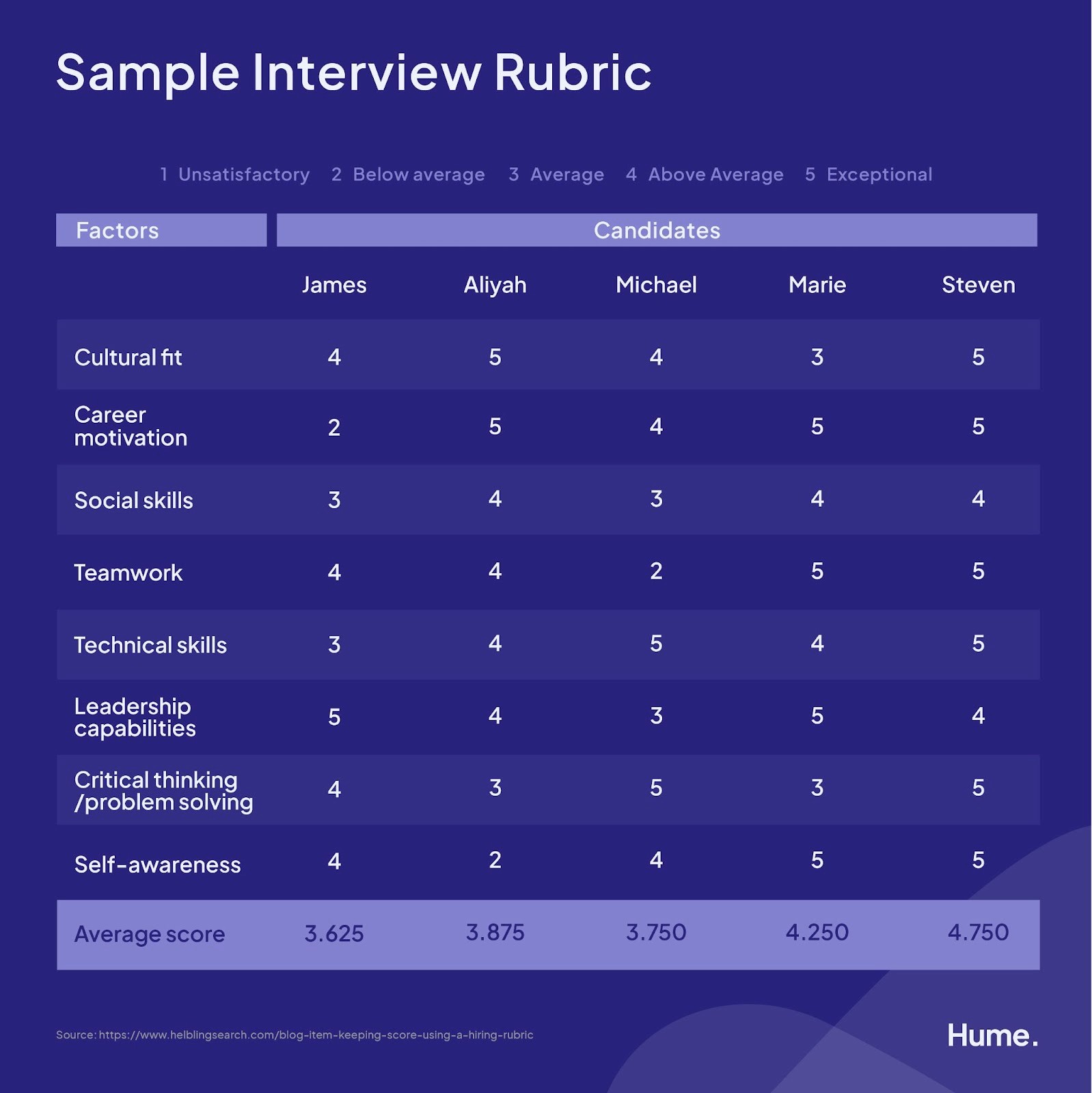
Keep in mind that it can be difficult to gauge something as weighty and abstract as "ability" over the course of just one conversation, which means rubrics are never an exact science. But they're a clean way to ensure candidates are all given a fair shake. To make the criteria even more objective, you can employ an interview panel. See next:
Interview by committee
The more input you have across your team about interviewees, the merrier. Why? Because more interviewers means a system of checks and balances are in place to mitigate biases. A hiring manager may have a good read on a candidate's soft skills. But a department head may be better at gauging more niche competencies, and whether that would-be employee can faithfully meet performance objectives.
What's more, having a whole interview panel lets you deliberate en masse about candidates after-the-fact, giving you a chance to see which of your assessments your team members agreed on, and which rang hollow. Just make sure that you have a solid argument for why you're either vying for or discounting a specific candidate, as you don't want the panel's collective opinion to conform toward the loudest (or most senior) voice.
It's also helpful if your group of interviewers is as diverse as possible — a mixture of ages, genders, seniority levels, and backgrounds. This is another hedge against any one interviewer's bias. It's also good practice to ensure the different interviews are asking the same questions across candidates.
Gathering a committee can also help reduce time to hire once you’ve found the ideal candidate. Lowering time to hire doesn’t just save your team energy, it also creates a better candidate experience that sets the stage for a happy and productive work relationship.
Give anonymous tests
Tests can be a perfect supplement to interviews, because you can assess candidates on skills directly related to the job at hand.
These tests can help you discern whether you want a candidate because you like them or because you think they'll be a value add. It also provides another handy way to compare candidates against one another.
To remove bias from the tests, it helps to judge them anonymously. This way, you're averting the risk of any unconscious biases you formed during the interview seeping their way into how you judge their test. While interviews are often a cordial way to let candidates' soft skills shine, tests can be a more dispassionate way of evaluating harder skills.
Minimize chitchat
This one can be a tough pill for hiring managers to swallow. While it's never a bad idea to be friendly, inane small talk questions before an interview can quickly turn into conversations fraught with bias. For example, if you found out someone is from your same hometown, and you used to go to the same restaurant after every school dance, you're likely to forge a bond with that candidate beyond the scope of the job, which can taint the whole hiring process.
To avoid this, after a quick few warm up questions, you may want to jump straight into the interview.
Double-check that first impression — in hindsight
Remember, first impressions are not to be trusted. But they're also inevitable. Therein lies an opportunity: your first impression bias of someone shouldn't be a bellwether, but it can be a helpful measuring stick to revisit towards the end of the hiring process. After deliberating with your team about the candidate and looking at their test, does that first impression hold weight? What about them surprised you in hindsight, and defied any quick-twitch notions?
Keep in mind that while they're untrustworthy, first impressions are more important for some jobs than others (for example, it's important that salespeople strike the right tone with potential customers right off the bat). Just make sure that first impression isn't the main thing you're measuring the candidate by.
Use reverse logic
One type of cognitive distortion we haven't mentioned by name yet: confirmation bias. This is our brain's way of favoring new information that validates previously held beliefs. For instance, we may interpret a potential red flag as a non-issue for a candidate we instantly like, or judge another candidate's shortcomings too harshly after having an awkward exchange at the beginning of an interview.
A good way to hedge against this is by taking note of your biases as soon as you have them, and then trying to see them from the opposite perspective. You may have thought one candidate was funny, but what misgivings do you have about her? The other didn't make eye contact, but wasn't the way he spoke of his prior experience impressive? By using this kind of reverse logic, you're neutralizing biases by entertaining the opposite viewpoint, instead of reaffirming them.
Record, transcribe, and annotate interview data
Memory doesn't play back like a videotape. Not only is it inherently unreliable. It also exacerbates unconscious bias. You may recall that fateful first impression far better than you'll be able to remember how candidates answered questions more relevant to the actual job.
That's why good notes are critical to successful interviews. The more they act as one-to-one transcriptions of what the interviewee actually said, the better you can evaluate candidates bias-free. This way, you have an objective document of actual answers, instead of your thoughts and feelings about those answers, which can cloud judgment.
Notes are also a helpful way for hiring managers to improve their interviews. You can assess which answers are most predictive of on-the-job performance, and tweak your strategy as you speak to more candidates.
Turning bias-free interviews from ideal to reality
As mentioned, great notes are one of the best ways to mitigate interview bias — especially if they're as close to a verbatim transcription as possible. But that's always been a tricky thing to accomplish manually. And it's even harder now, at a time when most virtual interviews are making the omnipresent bias problem even worse.
Why? Because when you take notes by hand or on the computer, you run the risk of missing important information. Plus, all that jotting distracts from the interview. And it's important that you're present for such a make-or-break conversation.
It can also be a huge pain rifling through all the notes once you're evaluating candidates. You remember that one interviewee offering that one important tidbit about the start-up they founded, but you're missing all the specifics.
What's more, candidate information can be cumbersome to share across your team. While interviewing by committee couches against bias, how do you deliberate and come to hiring decisions quickly — so that you don't miss out on that superstar candidate weighing all their options?
Dismantling interview bias with Hume
Bias, meet your nemesis.
Hume is an AI-powered hiring tool that records, transcribes, and annotates interviews to bring evidence, equity, and objectivity into the job hunt. It uses speech recognition technology to provide best-in-class transcripts of entire interview exchanges, allowing hirers to easily highlight the most crucial candidate information to share across teams.
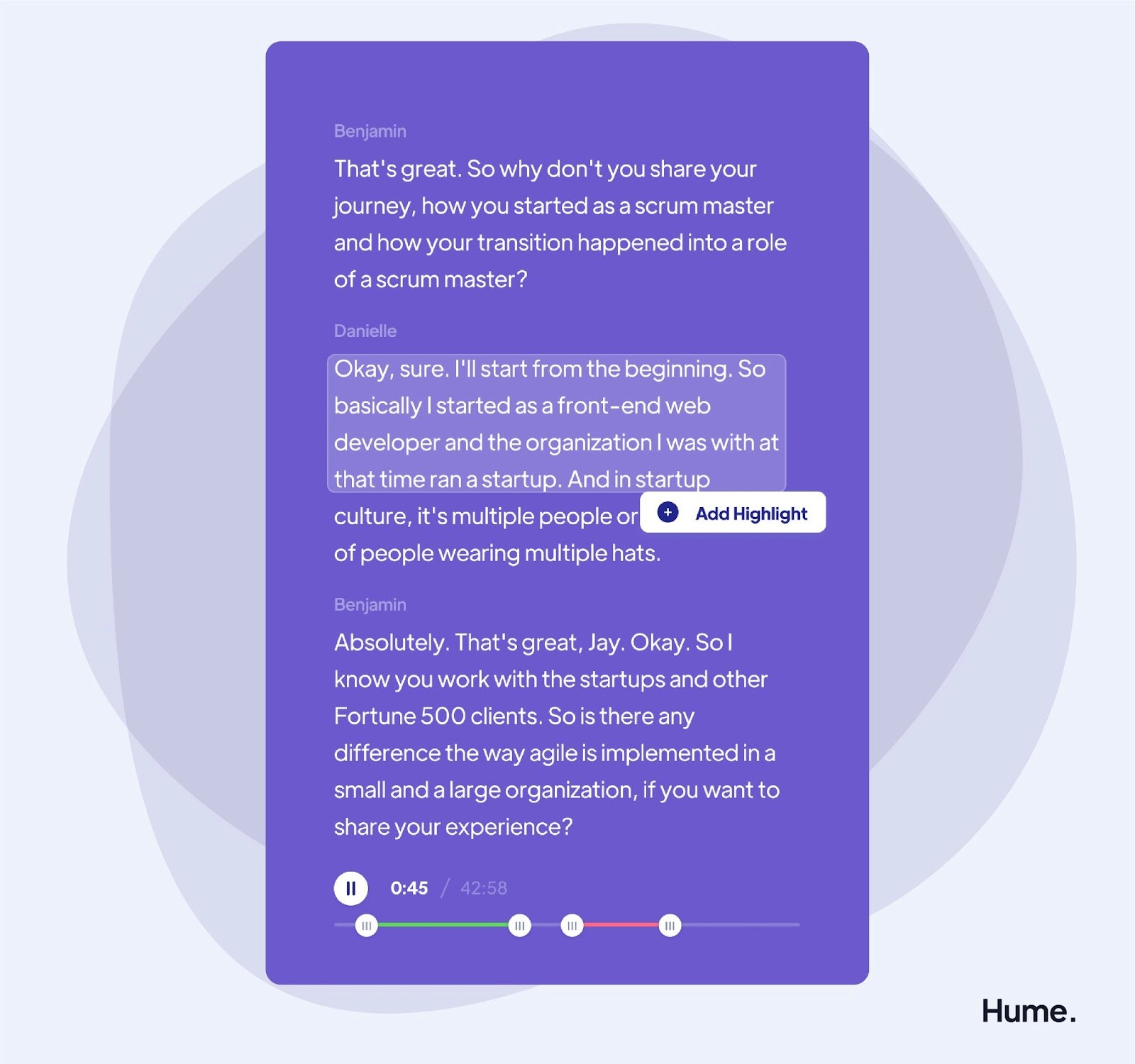
This way, you can spend less time note-taking, more time focused on the actual interview.
Hume also guides interviewers by providing real-time conversation metrics (for instance, how much you've listened vs. how much you've spoken, or questions asked vs. answered). It also offers personality assessments of candidates, and even creates highlight reels of every interview that can be easily shared across your hiring panel.
Not only does Hume make for a more equitable hiring process, free of unconscious bias. It also gives managers the opportunity to improve their interviewing skills — as most of them don't have any formal training — paving the way for a better candidate experience.
Interviews are delicate. When structured right, they can ensure stellar hires, improve diversity, and elevate workplace culture. But if you leave biases unchecked, you're not asking the right questions. And likely picking the wrong candidate.
Learn more about how Hume can ensure a bias-free interview experience by following our LinkedIn page here.
Imagine transforming every interview into a strategic advantage. Dive deep into every conversation, free from the distraction of note-taking. This isn't just wishful thinking – with Aspect, it's how you'll redefine your hiring process.
Beatriz F
People Success Specialist
Absolutely game-changing for busy recruiters!
The summary, the Q&A feature and the ATS integration have boosted my productivity and lowered the context-switching stress, the analytics provided allowed for me and my team to have full visibility over our stats, and Aspect's team couldn't be more helpful, friendly and accessible!
More Content On Talent Acquisition

